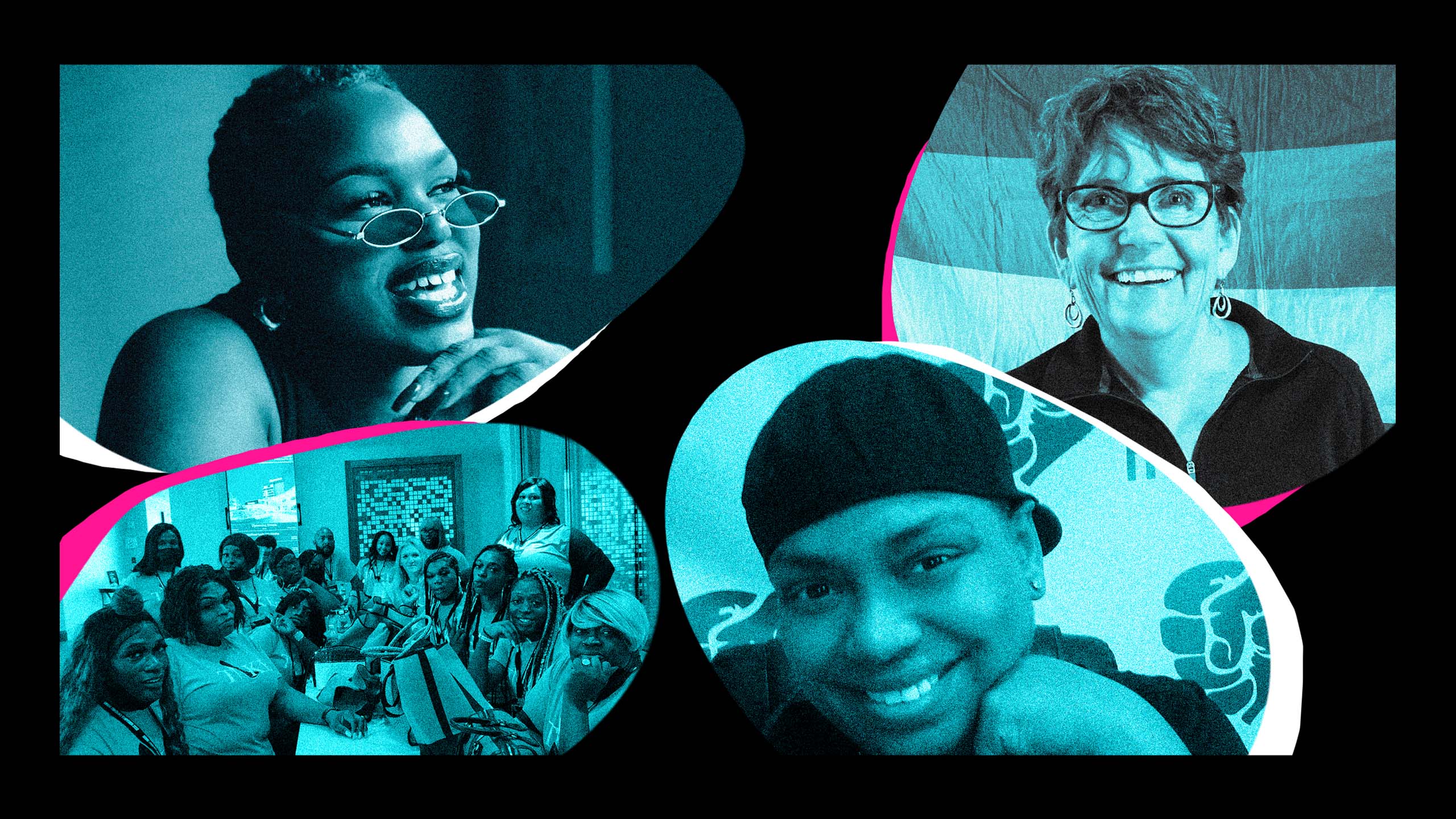After her apartment burned down several years ago, Angela Johnson had nowhere to go. As a Black trans woman living in Birmingham, Alabama, resources available in her situation were very few. However, once she found a community of peers at TAKE Birmingham, an advocacy and support centre for the local trans community, she was able to find housing, receive substance abuse treatment and, perhaps most important, feel safe and understood throughout the process. “It’s given me hope to go on to the next level of my life,” she says of her experience.
Situations like Johnson’s are not unique in the United States. According to True Colors United, a nonprofit combating homelessness among queer and trans youth, LGBTQ2S+ young people are 120 percent more likely to experience homelessness compared to straight, cisgender youth.
Although this is a nationwide issue, it looks a bit different for folks in the South. Colloquially known as the “Bible Belt,” the abundance of homophobic rhetoric and conservative politics like the slew of recent “Don’t Say Gay” bills and anti-trans legislation in this region can amplify these risks. It isn’t uncommon for queer and trans people to be fired by a conservative employer: either the company itself, or a right-wing boss, leading to financial instability. For youth, specifically, alienation within families and even disownment is a huge risk factor for homelessness. In a region that often prides itself on “Southern hospitality,” the circumstances for queer and trans people can be anything but welcoming.
“It’s sweet home Alabama. But it’s not so sweet when it comes to Black trans youth,” says Daroneshia Duncan-Boyd, founder of TAKE Birmingham. In Alabama, medical transition is legally banned for minors. Noncompliant parents may be accused of neglect, and doctors can lose their licences. In schools, K-12 grades are policing bathrooms, which can lead to bullying and dropouts. “You’re saying people don’t deserve an education if they’re not the norm. If they really care, they wouldn’t be afraid to centre Black trans folks,” says Duncan-Boyd.
When white middle- and upper-class people are placed in the spotlight, it creates an incomplete picture of the issue. Meanwhile, many LGBTQ2S+ people of colour from low-income backgrounds lack the same freedoms as their more privileged counterparts, especially freedom of mobility.
X Freelon, executive director of Lucie’s Place, a housing collective in Little Rock, Arkansas, adds, “We have young queer and trans adults who move out of Arkansas to metropolitan cities and get to experience living among a queer and trans-friendlier environment … they happen to oftentimes be white and educated, middle-class adjacent and/or wealthy. But those are not the people we serve.” Sandra Whitley, founder and director of Thrive Youth Center, a nonprofit serving queer and trans youth experiencing homelessness in San Antonio, Texas, also emphasizes the intersection between homelessness and socio-economic status: “A deeper root cause of becoming homeless is almost always generational poverty. It’s a systemic failure—exposing the areas of our society that are creating and reinforcing barriers to safety for all residents.”
Those left behind in the South consequently receive less housing protection. In Arkansas, landlords can legally evict renters “at will,” meaning living safely is dependent on, as Freelon puts it, “how any one landlord feels about you, how you look at any given time and how it triggers others’ biases.” The policies are similar in Tennessee. Phillis Lewis, CEO of Love Doesn’t Hurt, a Memphis-based nonprofit serving queer and trans victims of crime, says her home state is one of 10 (most of which are Southern) that lacks any protection for housing on the basis of sexuality and gender. With 85 percent of her clients being trans women of colour, especially those who have had past contact with law enforcement, structural protections are even more scarce. In understanding the nature of homelessness among LGBTQ2S+ folks, intersectionality is key. Those doing ground-level work recognize that a “one size fits all” approach to social issues is ineffective. Instead, a common theme among each of these organizations’ solutions is the importance of community-based approaches that centre its members, rather than themselves as saviours.
Duncan-Boyd specifies, “TAKE has been the blueprint for quite a few organizations throughout the South for being community-driven. I tell people all the time—continue to pour into Black trans communities, and don’t be afraid to name it.” Diamond Atkins, one of the women staying at Gloria’s Safe Haven, one of TAKE’s programs that provides housing for trans youth experiencing homelessness, says of the community: “You have to build some kind of sisterhood to make the best of a situation.” She described drag battles that she and the other residents throw, as well as her nail business that she provides to the other girls. In a similar vein, Whitley also speaks to the impact of a community-based model at Thrive: “We have seen how being in community helps our youth. Several of our alumni have joined the community’s Youth Action Board on Homelessness Policy. Two of our alumni just got married—and one of them is coming back to work at Thrive and continue supporting our work.”
These community-based approaches are a stark contrast to the typical homeless-shelter model, where there is a distinct hierarchy between staff and those receiving services. Rigid rules like curfews (not realistic for many people’s job schedules), kickout times and restrictions on pets and children make them sterile, unwelcoming places. “We don’t need any more shelters,” Freelon says. “What we need is a collective intent on engineering and reminding us that we are a collective and our needs are intertwined.”
Lucie’s Place has recently shifted their programming to better align with this vision. Moving away from the original transitional housing model, they are now a housing collective that primarily serves people of colour, ages 18 to 25, many of whom have come from families that have been disenfranchised for generations. For Freelon, this transition to a mutual housing collective model required imagining a different kind of future for Little Rock. When the spaces don’t exist, they have to dream about what a safe neighbourhood for people like them might look like.
Within a community-based framework, how do these organizations address issues surrounding homelessness? The resounding answer is that it happens holistically. Unlike the shelter model that attempts to solve problems based mainly on the provision of physical needs, these organizations focus on the whole person. “We’re coming from a place of trauma, and you’re never healed in one day—you’re healed in a lifetime,” Duncan-Boyd says. “We’re not just providing services like food, but being able to heal with the person’s wholeness, and find ways that bring joy.”
After beginning almost 10 years ago as a peer support group, TAKE is now a “one-stop shop” for supportive services and holistic healing, led by trans women of colour. At TAKE, staff are available 24 hours a day and show up as role models and peer support. Lucie’s Place has also adopted a holistic healing model. Their community aides work in assistance with folks at the centre to develop goal-management accountability systems. Freelon describes this as a “learning community” that encourages participants to work through their shame and challenges with adequate support.
Thrive has implemented a similar, trauma-informed approach. Beyond offering an emergency shelter and rapid rehousing, the organization also offers mental healthcare. Sandra explains that over half of the youth at their service become homeless due to an unsafe family home environment or familial rejection. “This creates a lot of difficult, hard work through trauma for our youth—and that compounds with the trauma experienced during bouts of homelessness.” In part, this is why their outreach work aims to prevent the trauma of homelessness to begin with, noting that it takes less than 48 hours on the streets before a young person experiences violence or is forced into criminal activity.
At Love Doesn’t Hurt, holistic healing involves working with businesses that are welcoming and affirming in their policies for their clients to apply for employment. Lewis also collaborates with Dress for Success, a global nonprofit supplying business attire for low-income women, to provide clothing, and she sets up job fairs. “I’ve seen clients who didn’t have anything to their name—an ID, social security card, clothes—and now they have their own secure housing, employment, and have continued along their journey and transitioning and are thriving. It’s a collective effort!” In each of these models, it’s not it’s not only about access to physical needs, but also psychological needs such as the need for autonomy—especially crucial when it’s been structurally denied.
In these organizations’ work, the most salient limitation often comes from elected officials in their states. In Southern states with mostly conservative politics, solutions often require working against existing policies, rather than collaboratively with them. In response, Freelon believes policy-makers should decolonize their mindset and instead work collaboratively with existing organizations at the local level. For officials who do support queer and trans communities, Duncan-Boyd notes their tendency to “reinvent the wheel” by making assumptions about what the community needs. She urges these officials to instead reach out to people already doing the work.
By implementing community-based solutions that focus on holistic healing, these groups not only alleviate tangible factors leading to homelessness, but also the underlying psychological repercussions of discrimination such as shame and internalized stigma. It’s not just about helping queer and trans people in the South survive an environment that is non-nurturing at best, and life-threatening at worst. Instead, the goal is flourishing. “You plant that seed and you continue to pour water on it until something blossoms,” Duncan-Boyd says of her work. And for any flower to bloom, it’s absolutely necessary to have good soil. For queer and trans Southerners, this soil looks like caring, affirming environments with community-based care.


 Why you can trust Xtra
Why you can trust Xtra


